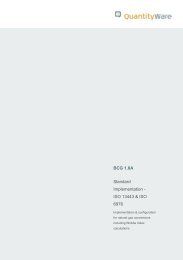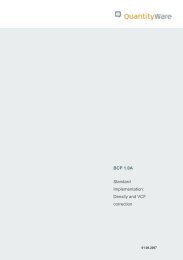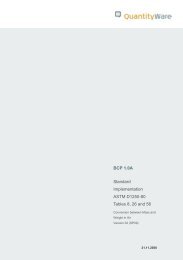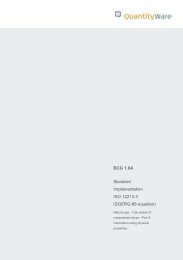QuantityWare - ASTM D1250-04_ASTM_D1250-80 comparison
QuantityWare - ASTM D1250-04_ASTM_D1250-80 comparison
QuantityWare - ASTM D1250-04_ASTM_D1250-80 comparison
- No tags were found...
Create successful ePaper yourself
Turn your PDF publications into a flip-book with our unique Google optimized e-Paper software.
4.2.2. Tables 23 and 24 <strong>comparison</strong> runFor these tables, we chose the starting and ending relative density as well as the temperaturerange in °F according to table 3. The relative density value was increased by 0,0001 percalculation, the temperature by 0,1 °F per calculation.Firstly, the <strong>ASTM</strong> <strong>D1250</strong>-<strong>04</strong> implementation was called with these values. In order to do so, therelative density values were converted to kg/m³ values and no additional rounding wasperformed. The °F values were passed to directly the implementation.The resulting exact base density values were converted back to relative density values andthese final values were rounded as defined in table 2. We obtained three VCF values, the valuerounded to five decimals and the exact value, which we rounded to two VCF with four decimals(one statistically rounded, one commercially rounded).The <strong>ASTM</strong> <strong>D1250</strong>-<strong>80</strong> implementation was called with the increment values as defined in table1, followed by the <strong>ASTM</strong> <strong>D1250</strong>-<strong>80</strong> defined input value rounding, (occurring within theimplementation). After input value rounding, relative density was converted to an absolutedensity value in kg/m³ and that value was rounded to 0,01 kg/m³ by the implementation.We also noted if the <strong>ASTM</strong> <strong>D1250</strong>-<strong>80</strong> calculation was outside the <strong>ASTM</strong> <strong>D1250</strong>-<strong>80</strong> definedranges; such range extension calculations may fail due to the less robust convergence schemeand differing number format.4.2.3. Tables 53, 54, 59 and 60 <strong>comparison</strong> runFor these tables, we chose the starting and ending absolute density as well as the temperaturerange in °C according to table 3. The absolute density starting value was increased by 0,1 percalculation, the temperature by 0,05 °C per calculation.Firstly, the <strong>ASTM</strong> <strong>D1250</strong>-<strong>04</strong> implementation was called with these values. In order to do so, theabsolute density values in kg/m³ values were passed without additional rounding to thecalculation procedure. The °C values were converted to ° F values and passed to theimplementation directly without further rounding.The resulting exact base density values in kg/m³ were rounded as defined in table 2. Weobtained three VCF values, the value rounded to five decimals and the exact value, which werounded to two VCF with four decimals (one statistically rounded, one commercially rounded).The <strong>ASTM</strong> <strong>D1250</strong>-<strong>80</strong> implementation was called with the increment values without furtherconversion; internal rounding as defined in table 1 was performed within the implementation.Comparison of <strong>ASTM</strong> <strong>D1250</strong>-<strong>04</strong> and <strong>ASTM</strong> <strong>D1250</strong>-<strong>80</strong> 21/49



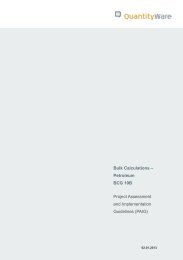
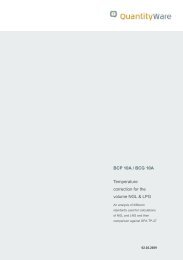

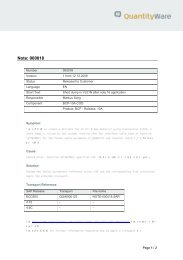
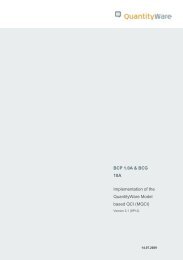
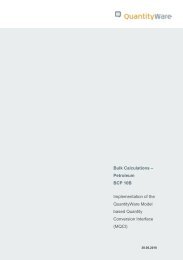
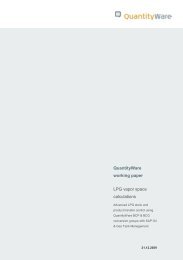
![Petroleum ASTM D1250-80 SP09 [276.9 KByte] - QuantityWare](https://img.yumpu.com/48083876/1/184x260/petroleum-astm-d1250-80-sp09-2769-kbyte-quantityware.jpg?quality=85)
![SAP QCI in a Nutshell + Notes [761.4 KByte] - QuantityWare](https://img.yumpu.com/46691308/1/178x260/sap-qci-in-a-nutshell-notes-7614-kbyte-quantityware.jpg?quality=85)
